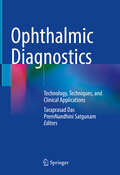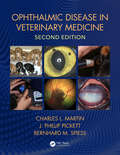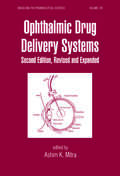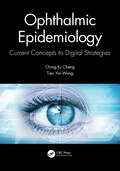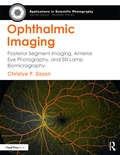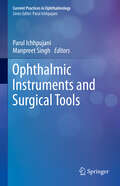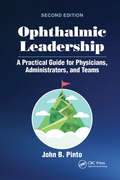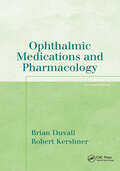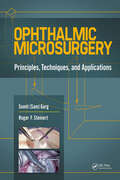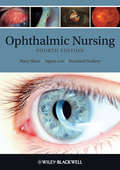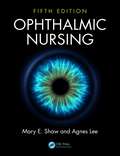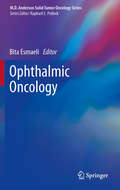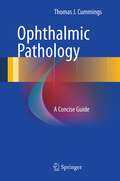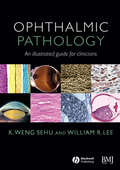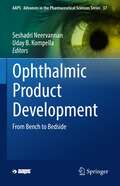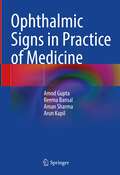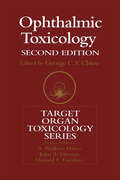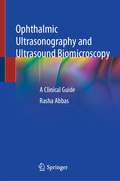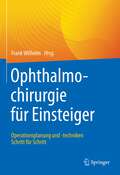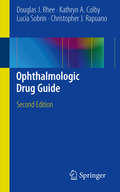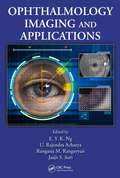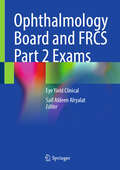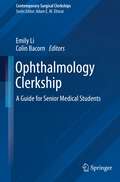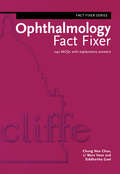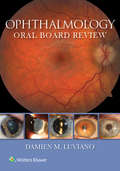- Table View
- List View
Ophthalmic Diagnostics: Technology, Techniques, and Clinical Applications
by Taraprasad Das PremNandhini SatgunamThe book comprehensively covers three aspects of diagnostic tests in eye care. It lays equal emphasis on the technology associated with the ophthalmic tests, on appropriate techniques to maximize the input and the clinical applications for comprehensive understanding and usage of ophthalmic diagnostic tests. The book also includes many newer diagnostic devices not described earlier such as teleophthalmology, homecare, and smartphone-based ophthalmic diagnostics.The contributing authors are from renowned ophthalmic and optometry fraternities worldwide and are experienced clinicians and scientists.It’s a must-have book for ophthalmologists, optometrists, and ophthalmic assistants, who want to stay abreast with the latest developments in the field.
Ophthalmic Disease in Veterinary Medicine
by Charles L. Martin J. Phillip Pickett Bernhard M. SpiessFeaturing a new author team, this seminal book has been completely updated and significantly expanded. Following an outline of the basic elements of ophthalmic science relevant to study and practice, the authors provide a detailed description and discussion of each condition including etiology, clinical signs, diagnosis, prognosis, and therapy, as well as a section dedicated to presumed inherited eye disorders. The focus throughout remains on the clinical needs of the practitioner and the student. Beautifully illustrated in full color, the book is aimed at trainee and practicing veterinarians interested in all types of ophthalmic diseases and disorders. Although the focus is on small animals, there is additional material on the horse and the cow. For this edition, a diverse group of authors from many geographic regions of training and practice offer a breadth of clinical expertise.
Ophthalmic Drug Delivery Systems
by Ashim K. MitraThe second edition of this text assembles significant ophthalmic advances and encompasses breakthroughs in gene therapy, ocular microdialysis, vitreous drug disposition modelling, and receptor/transporter targeted drug delivery.
Ophthalmic Epidemiology: Current Concepts to Digital Strategies
by Ching-Yu ChengOphthalmic Epidemiology: Current Concepts to Digital Strategies provides a comprehensive guide to graduate students, ophthalmologists, and researchers in ophthalmic epidemiology. It covers recently developed new methodologies, technologies and resources in ocular epidemiological research, such as telemedicine, disease registries, EMR, bio-banks and omics. This book also summarizes recent epidemiological findings and provides up-to-date data on ocular diseases. Furthermore, it introduces and discusses the uses of epidemiology in the evaluation of health services and population screening programs and reviews the application of epidemiology in intervention trials in the communities. Key Features Comprehensive guide to the epidemiology of common eye diseases. Provides updates on the prevalence and risk factors of eye diseases. Outlines how epidemiological techniques can be utilized to evaluate ophthalmic health services and programs.
Ophthalmic Imaging: Posterior Segment Imaging, Anterior Eye Photography, and Slit Lamp Biomicrography (Applications in Scientific Photography)
by Christye SissonOphthalmic Imaging serves as a reference for the practicing ophthalmic imager. Ophthalmic imaging combines photography and diagnostic imaging to provide insight into not only the health of the eye, but also the health of the human body as a whole. Ophthalmic photographers are specialists in imaging through and in the human eye, one of the only parts of the body where the circulation and nervous system is visible non-invasively. With technical perspective as context, this book will provide instructional techniques as well as the background needed for problem solving in this exciting field. The book covers all aspects of contemporary ophthalmic imaging and provides image support to ophthalmologists and sub-specialties including retinal specialists, corneal specialists, neuro-ophthalmologists, and ocular oncologists. This text serves as a reference for the practicing ophthalmic imager, or to imagers just getting started in the field.
Ophthalmic Instruments and Surgical Tools (Current Practices in Ophthalmology)
by Manpreet Singh Parul IchhpujaniThe goal of this book is to offer readers essential information on the morphological features of ophthalmic surgical instruments, their possible uses, and intraoperative handling of the standard and latest instrumentation across ophthalmology subspecialties. Detailed content on basic and advanced instruments for both anterior and posterior segment surgeries is also provided, helping readers use them in the most effective and efficient manner. This handy manual also provides valuable insights into proper sterilization techniques, suture materials, and common OR equipment and machines. The text is richly illustrated throughout.As part of the series “Current Practices in Ophthalmology”, this volume is intended for residents, fellows-in-training, generalist ophthalmologists, and specialists alike.
Ophthalmic Leadership: A Practical Guide for Physicians, Administrators, and Teams
by John B. PintoOphthalmic practices have many types of leaders, functioning at all levels of the organization. Ophthalmic Leadership: A Practical Guide for Physicians, Administrators, and Teams, Second Edition can provide each of these leaders with the tools to be more decisive, motivating, and effective.John B. Pinto, America’s most published author on the business of ophthalmology, has firsthand experience with the best and worst practice leadership habits from his decades of experience as an ophthalmic practice consultant. He has coached countless physician and lay leaders to the next level of their careers. Together with his team of more than 20 expert contributors, Pinto covers every aspect of leadership in ophthalmology, no matter the size of the practice or the current experience of the team.Chapters include: What Do You Believe in? Developing a List of Core Values for Your Practice Grooming and Moving Line Staff Up to Middle Management Contingency Planning in a Less-Certain Environment Leading Your Team Past the Inevitable Conflicts of Practice Life Everyone in ophthalmology can benefit from the lessons inside Ophthalmic Leadership: A Practical Guide for Physicians, Administrators, and Teams, Second Edition—from the rising ophthalmic technician or department manager, to the managing partner, and even the most seasoned practice administrator.“The book you now hold is a wonderful opportunity to rededicate yourself to your professional development as a leader and to the success of your organization.”From the Foreword by Richard L. Lindstrom, MD
Ophthalmic Medications and Pharmacology (The Basic Bookshelf for Eyecare Professionals)
by Brian Duvall Robert M. KershnerFor those who are new to the subject, ocular pharmacology can be a difficult and sometimes overwhelming topic. Ophthalmic Medications and Pharmacology, Second Edition is a reader-friendly guide that provides a quick review and basic clinical reference of ocular pharmacology.In this updated and revised second edition, Drs. Duvall and Kershner present an overview to the medication and drugs found most commonly in ophthalmic practice without overwhelming those professionals new to the subject. Ophthalmic Medications and Pharmacology concisely reviews commonly used and prescribed medications, how they work, dosage, therapeutic use, and potential side effects. This new edition also highlights key information for patients about the medications they encounter and are prescribed in the clinic.Ophthalmic staff, students, and research professionals looking for an introduction and basic go-to guide will welcome having a copy of Ophthalmic Medications and Pharmacology by their side.New to this edition:· An appendix focused on the drug approval process.· A chapter on retinal therapies.· Study icons to assist in the learning process.· New coverage of vasoconstrictors.
Ophthalmic Microsurgery: Principles, Techniques, and Applications
by Sumit Garg Roger SteinertExcellent microsurgery derives not from natural dexterity alone or from pure book knowledge, but from these features combined with an appreciation of the instrumentation, physical forces, and tissue reactions that create the environment of microsurgery. Ophthalmic Microsurgery: Principles, Techniques, and Applications conveys both the art and science of microsurgery from an ophthalmic perspective.This unique resource begins with the principles and techniques of microsurgery, which can be applied to all types of surgeries and includes detailed laboratory exercises to teach the key concepts. The second section of Ophthalmic Microsurgery addresses the specific applications. While not an encyclopedia of all surgical interventions, Drs. Sumit “Sam” Garg and Roger Steinert, along with their contributors, provide an overview of key surgical competencies that are relevant to the various ophthalmic subspecialties.Ophthalmic Microsurgery is set apart from other similar resources by having a comprehensive and concise focus on translating surgical principles into reality through simple and inexpensive exercises.Grounded in practicality and requiring only basic materials, Ophthalmic Microsurgery: Principles, Techniques, and Applications covers the theory and basics of microsurgery needed during the ophthalmic surgical training of residents and fellows and serves as an excellent manual for the more experienced ophthalmologists looking to refine their technique in microsurgery.
Ophthalmic Nursing
by Agnes Lee Mary E. ShawThere have been many changes in the arena of ophthalmic care since the last edition of this book was published. This fourth edition has been fully updated and revised to reflect these recent advances in care, and incorporates new information on patient care, contexts of care, and expanded roles. It includes a greater emphasis on the primary care setting, more information on issues such as new treatments, infection control, and use of technology, greater detail on theatre, anaesthetics and recovery, and new information on the role of other healthcare professionals involved in ophthalmic care. Now with colour illustrations throughout, this accessible text also includes evidence-based procedure guidelines and reflective practice exercises that enable the reader to apply the learning in practice. Written by highly regarded authors based at The University of Manchester and Manchester Royal Eye Hospital, Ophthalmic Nursing is a must-have for every eye department.
Ophthalmic Nursing
by Agnes Lee Mary E. ShawOphthalmic Nursing provides an overview for those just setting out in a role within ophthalmic nursing. It includes basic and comprehensible anatomy and physiology – the foundations for understanding how the eye functions and why and how problems occur – and relates them to the care and needs of the patient. This accessible text includes evidence-based procedure guidelines and the inclusion of reflective activities in most chapters allows readers to apply their knowledge to the realities of the care setting. Also covered are the most recent National Institute for Health and Care Excellence (NICE) guidelines for glaucoma and age-related macular degeneration. Since the publication of the fourth edition, there have been many advances in the care and management of the ophthalmic patient. The authors have updated the chapters accordingly and included new colour images and diagrams. References, further reading and websites have also been updated to reflect current trends. A valuable resource for nurses in practice and training, this book continues to be the ‘go-to’ source for those caring for the ophthalmic patient.
Ophthalmic Oncology
by Bita EsmaeliThis book highlights the unique aspects of oncologic ophthalmology as a medical and surgical discipline practiced at a comprehensive cancer center. Multi-disciplinary management of ocular, orbital and adnexal cancers are highlighted using simple and tried-and-true algorithms. In addition, ocular problems caused as a direct result of cancer treatment are reviewed using illustrative photographs and case presentations. The content is provided by full-time ophthalmology faculty and fellows at M. D. Anderson Cancer Center. Experts in complementary disciplines such as ophthalmic pathology, dermatopathology, radiation oncology, radiology, and other surgical subspecialties have brought their unique perspective to each chapter. The book is abundant with clinical photographs as well as interesting case presentations that will help the clinician correctly diagnose cancers of the orbit, eye, and adnexal structures, initiate appropriate management, as well as recognize and treat common ocular complications of cancer therapy.
Ophthalmic Pathology
by Thomas J CummingsOphthalmic Pathology: A Concise Guide provides an introductory book of essential and fundamental information that will give the reader a solid foundation in ophthalmic pathology. The volume differs from the available classic and comprehensive ophthalmic pathology textbooks in its basic and simplified 'one month approach' concept. The text is rich in macroscopic and microscopic pathology images, clinical images, and bullet-point lists. Each chapter (Overview; Cornea; Conjunctiva; Eyelids; Uveal Tract; Retina; Orbit; and, Optic Nerve) includes approximately 30 color figures of common eye pathology diagnoses and also reviews the normal histology of each ocular component. An assortment of commentary related to common diagnoses and differential diagnostic considerations, clinical and pathological correlations, pearls and pitfalls, and ophthalmic pathology terminology can be found in each chapter. Other topics include: the fundamental pathology of glaucoma, trauma, cataracts, macular degeneration, and the phacomatoses; commonly used histochemical stains employed in ophthalmic pathology; and basic prosection of enucleation and evisceration specimens.
Ophthalmic Pathology: An Illustrated Guide for Clinicians
by K. Weng Sehu William R. LeeHighly Commended at the Society of Authors and Royal Society of Medicine Medical Book Awards 2006 This outstanding atlas of ophthalmic pathology brings together the world famous collection of digital images from the Tennant Eye Institute in Glasgow. Weng Sehu and William Lee have produced a unique body of information, moulding Ophthalmic Pathology and the accompanying interactive CD-Rom into the essential ‘must-have’ revision aid and reference book for ophthalmologists in training, teachers and clinical ophthalmologists worldwide. Ophthalmic Pathology is a concise, yet informative, user friendly textbook whose unparalleled image collection will more than meet the expectations of the ophthalmological community.
Ophthalmic Product Development: From Bench to Bedside (AAPS Advances in the Pharmaceutical Sciences Series #37)
by Uday B. Kompella Seshadri NeervannanThis is a comprehensive textbook addressing the unique aspects of drug development for ophthalmic use. Beginning with a perspective on anatomy and physiology of the eye, the book provides a critical appraisal of principles that underlie ocular drug product development. The coverage encompasses topical and intraocular formulations, small molecules and biologics (including protein and gene therapies), conventional formulations (including solutions, suspensions, and emulsions), novel formulations (including nanoparticles, microparticles, and hydrogels), devices, and specialty products. Critical elements such as pharmacokinetics, influence of formulation technologies and ingredients, as well as impact of disease conditions on products development are addressed. Products intended for both the front and the back of the eye are discussed with an eye towards future advances.
Ophthalmic Signs in Practice of Medicine
by Aman Sharma Arun Kapil Amod Gupta Reema BansalThe book provides basic knowledge of clinical ophthalmic signs and their application in the clinical practice of medicine. It discusses several intra and extraocular signs that help the ophthalmologists to reach a diagnosis and suggest the presence or absence of an underlying severe sight-threatening or even life-threatening disease, such as diabetes, hypertension, cardiovascular disease, hematological disorders, systemic vasculitis, rheumatological disorders, brain tumors, sarcoidosis, or infectious diseases caused by M. tuberculosis, HIV or herpes viruses. The book is divided into two sections and each chapter is dedicated to one ophthalmic sign providing its pathophysiology, significance, differential diagnosis and clues to systemic disease. Each chapter is profusely illustrated with color and black and white images, and boxes with key messages on differential diagnosis and appropriate laboratory investigations. This book serves as a one-stop resource discussing the significance of individual ophthalmic signs and their context to sensitize the physicians, both the graduates and postgraduates in training, residents and fellows in ophthalmology, family medicine and internal medicine, and practicing physicians.
Ophthalmic Toxicology
by G. C. ChiouThoroughly revised and updates, this new edition of Ophthalmic Toxicology retains its uniqueness in covering all aspects of ophthalmic toxicology. With chapters from leading authorities incorporating the latest developments in the field, including a new chapter on the molecular basis of ophthalmic toxicity, this edition covers such topics as:*t
Ophthalmic Ultrasonography and Ultrasound Biomicroscopy: A Clinical Guide
by Rasha AbbasThis book provides a visual overview of how to master ultrasonography and ultrasound biomicroscopy techniques. Updated ultrasonic information is included in a simple brief way, featuring didactic points, with a variety of documented scans and illustrated lines underneath for more clarification. Each pathology is accompanied with several scans of different findings to give more information of distinct detections.Ophthalmic Ultrasonography and Ultrasound Biomicroscopy: A Clinical Guide examines many clinical complexities with possible solutions when performing and interpreting ultrasound while also breaking down information for easier intake. The clinical cases are from a specialist eye hospital where many complicated cases are treated, giving a unique insight for the reader to understand treatment for a variety of cases. The book also emphasises the importance of everyday cases with further explanation whilst utilising a diversity of pictures and labels.
Ophthalmochirurgie für Einsteiger: Operationsplanung und -techniken Schritt für Schritt
by Frank WilhelmEin extrem hilfreiches Lehrbuch für die AugenchirurgieFür die ersten operativen Eingriffe in der Ophthalmochirurgie enthält dieses Buch für den Arzt in der Weiterbildung zahlreiche Hinweise und Empfehlungen. Dieses einmalige Praxisbuch bündelt die Erfahrung von vielen Praktikern und ist ein Must-have für ein gutes Gelingen der ersten Operationen am Auge.Die notwendigen Schritte in der Operationsplanung, Lokalanästhesie, Nahttechniken, Nahtmaterial, Schnitttechniken und der jeweilige OP-Ablauf werden dargestellt. Das OP-Lehrbuch zeichnet sich durch zahlreiche Abbildungen aus. Instruktive Schemazeichnungen veranschaulichen einzelne Operationsschritte und das Vorgehen. Mit vielen Tipps von erfahrenen Operateuren - auch, um Pittfalls zu vermeiden. Für alle Weiterbildungsassistenten in der Augenheilkunde zur Vorbereitung auf erste Operationen am Auge.
Ophthalmologic Drug Guide
by Christopher J. Rapuano Douglas J. Rhee Lucia Sobrin Kathryn A. Colbyto follow
Ophthalmological Imaging and Applications
by Jasjit S. Suri Rangaraj M. Rangayyan U. Rajendra Acharya E. Y. K. NgEdited by and featuring contributions from world-class researchers, Ophthalmological Imaging and Applications offers a unified work of the latest human eye imaging and modeling techniques that have been proposed and applied to the diagnosis of ophthalmologic problems, including inflammation, cataracts, diabetic retinopathy, and glaucoma. With a foc
Ophthalmology Board and FRCS Part 2 Exams: Eye Yield Clinical
by Saif Aldeen AlryalatThe book provides the ophthalmology knowledge necessary for students and residents aiming to pass critical clinical exams such as the FRCOphth Part 2, FRCS Part 2, and the American Board of Ophthalmology clinical exam. Additionally, it covers national clinical board exam, owing to inclusion of various sources of clinical question banks. It fills a crucial gap by offering insights that go beyond classical textbooks to address what these exams specifically test. The book is drafted from updated literature and over 10,000 existing ophthalmology questions curated by leading professionals in the field. The chapters delve into essential topics like diagnostic methods, treatment strategies, and recent advancements in ophthalmology. With comparative tables and concise summaries, this book ensures focus on the highest yield information. The chapters are organized to highlight commonly overlooked frequently tested topics. The book provides a clear path through complex subject matter by incorporating recent literature and resolving longstanding controversies. The book targets ophthalmology residents, students, and fellows preparing for exams, practicing ophthalmologists will also benefit from up-to-date information and summarized evidence on nearly all ophthalmology topics. This book is an invaluable tool for anyone within the field seeking to enhance their knowledge base with insights from experts supported by recent research.
Ophthalmology Clerkship: A Guide for Senior Medical Students (Contemporary Surgical Clerkships)
by Emily Li Colin BacornThis quick-reference guide is the first book written specifically for the many third- and fourth-year medical students rotating on the ophthalmology service. The book focuses on the diagnosis and management of the most common pathologic entities. Each chapter covers history, physical examination, imaging, and common diagnoses. For each diagnosis, the book sets out the typical presentation, options for non-operative and operative management, and expected outcomes. Chapters include key illustrations, quick-reference charts, tables, diagrams, and bulleted lists. Students can read the text from cover to cover to gain a general foundation of knowledge that can be built upon when they begin their rotation, then use specific chapters to review a sub-specialty before starting a new rotation or seeing a patient with a sub-specialty attending. Topics covered include glaucoma, cataracts, retinal tears, macular degeneration, ptosis, strabismus, thyroid eye disease, and much more.Practical and user-friendly, Ophthalmology Clerkship is the ideal, on-the-spot resource for medical students and practitioners seeking fast facts on diagnosis and management. Its bullet-pointed outline format makes it a perfect quick reference, and its content breadth covers the most commonly encountered problems in clinical practice.
Ophthalmology Fact Fixer: 240 MCQs with Explanatory Answers
by Siddhartha Goel Chung Nen Chua Li Wern VoonSo what's so special about doctors and their families? Many doctors feel that they are expected to give too much of their time to a medical career to the detriment of their family and their personal lives. This book is a practical guide to provide support and ideas on how to cope with stresses directly suffered or passed on from a relative or spouse. Written in a clear and practical style using information collated from family members describing their feelings about having a doctor in the family it provides unique and vital information on how to minimise the effects of having a medical career on the family. Essential reading for doctors and their families.
Ophthalmology Oral Board Review: A Last Minute Review For The Boards
by Damien LuvianoPacked with 65 sample cases covering all core topics, Ophthalmology Oral Board Review is an image-based case review designed to help you prepare—and succeed—on the American Board of Ophthalmology oral board certification exam. Regardless of your level of experience, the book features simple tools, advice, and tactics to become more organized, assertive, and confident in delivering case presentations.
